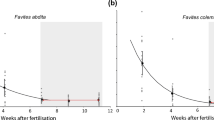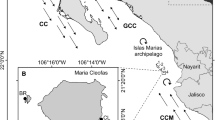Abstract
In order to establish a successful method for the transplantation of branching and tabular coral fragments, we tested the effects of orientations of attachment, seasons of transplantation, and size of fragments on survival, growth, and spawning using Acropora formosa and A. hyacinthus. Vertically attached, large-sized fragments of A. formosa showed 98–100% survival rate after 18 months. The fragments transplanted in August exhibited better survival than those transplanted in November. The larger fragments had the higher percentage of spawning. The fragments that spawned had lower growth rate, while those resorbed the oocytes carried at the time of transplantation showed higher growth rate, suggesting the trade-off between growth and reproduction. Half of the fragments spawned 1 month earlier than the donor colonies. Only the vertically attached fragments of A. hyacinthus fused to the substratum, and those transplanted in February showed 100% survival rate after 14 months, indicating that this species is well suited for transplantation.





Similar content being viewed by others
References
Auberson B (1982) Coral transplantation: an approach to the re-establishment of damaged reefs. Kalikasan Philipp J Biol 11:158–172
Baird AH, Marshall PA (2002) Mortality, growth and reproduction in scleractinian corals following bleaching on the Great Barrier Reef. Mar Ecol Prog Ser 237:133–141
Bak RPM, Engel MS (1979) Distribution, abundance and survival of juvenile hermatypic corals (Scleractinia) and the importance of life history strategies in the parent coral community. Mar Biol 54:341–352
Bowden-Kerby A (1997) Coral transplantation in sheltered habitats using unattached fragments and cultured colonies. In: Proceedings of 8th international coral reef symposium Panama 2:2063–2068
Bruckner AW, Bruckner RJ (2001) Condition of restored Acropora palmata fragments off Mona Island, Puerto Rico, two years after the Fortuna Reefer ship grounding. Coral Reefs 20:235–243
Chen G, Xiong S (1995) A study on the transplantation of reef-building corals in Sanya waters, Hainan province. Trop Oceanol 14(3):51–57
Clark T (1997) Tissue regeneration rate of coral transplants in a wave exposed environment, Cape D’Aguilar, Hong Kong. In: Proceedings of the 8th International Coral Reef Symposium Panama 2:2069–2074
Clark S, Edwards AJ (1995) Coral transplantation as an aid to reef rehabilitation: evaluation of a case study in the Maldives Islands. Coral Reefs 14:201–213
Connell J (1973) Population ecology of reef building corals. In: Jones OA, Endean R (eds) Biology and geology of coral reefs 2, biology 1. Academic, New York, pp 205–245
Custodio III HM, Yap HT (1997) Skeletal extension rates of Porites cylindrica and Porites (Synaraea) rus after transplantation to two depths. Coral Reefs 16:267–268
Edwards AJ, Clark S (1998) Coral transplantation: A useful management tool or misguided meddling?. Mar Poll Bull 37:474–487
English S, Wilkinson C, Baker V (1997) Survey manual for tropical marine resources, 2nd edition. Australian Institute of Marine Science, Townsville
Grassle JF (1973) Variety in coral communities. In: Jones OA, Endean R (eds.) Biology and geology of coral reefs, vol II, Biology 1. Academic, New York, pp 247–270
Harriott VJ, Fisk DA (1988) Coral transplantation as a reef management option. In: Proceedings of the 6th International Coral Reef Symposium, Australia 2:375–379
Hayashibara T, Shimoike K, Kimura T, Hosaka S, Heyward A, Harrison P, Kudo K, Omori M (1993) Patterns of coral spawning at Akajima Island, Okinawa, Japan. Mar Ecol Prog Ser 101:253–262
Highsmith RC (1982) Reproduction by fragmentation in corals. Mar Ecol Prog Ser 7:207–226
Iwao K (2001) Observation of oceanographic data at Akajima Island from 1995–2000 (in Japanese). Midoriishi 12:21–25
Kojis BL, Quinn NJ (1985) Puberty in Goniastrea favulus: age or size limited? Proceedings of the 5th International Coral Reef Congress, Tahiti 4:289–293
Marine Parks Center of Japan (1995) Research report on rehabilitation methodology of coral reef ecosystems. Environment Agency Contract Research Report, 87p
National Astronomical Observatory (2000) Chronological Scientific Tables 2000. Maruzen Co., Ltd, 1064p
Nishihira M, Veron JEN (1995) Hermatypic corals of Japan. Kaiyusya publishers Co., Ltd, 439p
Okubo N (2003) Development of underwater techniques for coral reef restoration, experiment 6–2. In: Study on the disturbance and restoration of the coral reef (in Japanese). Research and Information Office, Global Environment Bureau, Ministry of the Environment, Government of Japan summary report of research results global environment research fund in 2002, pp 185–193
Okubo N, Omori M (2001) The review of coral transplantation around the world (in Japanese with English abstract). Galaxea 3:31–40
Omori M, Okubo N (2004) Previous research and undertaking of coral reefs restoration. In: Omori M, Fujiwara S (eds) Manual for restoration and remediation of coral reefs. Nature Conservation Bureau Ministry of the Environment, Japan, pp 3–13
Plucer-Rosario GP, Randall RH (1987) Preservation of rare coral species by transplantation: an examination of their recruitment and growth. Bull Mar Sci 41:585–593
Rinkevich B, Loya Y (1989) Reproduction in regenerating colonies of the coral Stylophora pistillata. In: Spanier E, Steinberger Y, Luria M (eds) environmental quality and ecosystem stability, vol IVB. Environmental quality. Israel Society for Environmental Quality Sciences Publication, Jerusalem Israel, pp 259–265
Sheppard CRC (1981) The reef and soft-substrate coral fauna of Chagos, Indian Ocean. J Nat Hist 15:607–621
Smith LD, Hughes TP (1999) An experimental assessment of survival, re-attachment and fecundity of coral fragments. J Exp Mar Biol Ecol 235:147–164
Szmant-Froelich A (1985) The effect of colony size on the reproductive ability of the Caribbean coral Montastrea annularis (Ellis and Solander). In: Proceedings of 5th International Coral Reef Symposium 4:295–300
Taniguchi H (2001) Measurements of time-averaged intensity of water motion around Akajima Island (in Japanese). Midoriishi 12:18–20
Taniguchi H, Iwao K, Omori M (1999) Coral bleaching around Akajima, Okinawa I. A report of the September 1998 survey (in Japanese with English abstract). Galaxea, JCRS 1:59–64
Veron JEN (2000) Corals of the world, vol 1. Australian Institute of Marine Science, Townsville
Ward S (1995) Two patterns of energy allocation for growth, reproduction and lipid storage in the scleractinia coral Pocillopora damicornis. Coral Reefs 14: 87–90
Yap HT, Gomez ED (1984) Growth of Acropora pulchra. Responses of natural and transplanted colonies to temperature and day length. Mar Biol 87:209–215
Yap HT, Aliño PM, Gomez ED (1992) Trends in growth and mortality of three coral species (Anthozoa: Scleractinia), including effects of transplantation. Mar Ecol Prog Ser 83:91–101
Yap HT, Alvarez RM, Custodio HM, Dizon RM (1998) Physiological and ecological aspects of coral transplantation. J Exp Mar Biol Ecol 229:69–84
Zakai D, Levy O, Chadwick-Furman NE (2000) Experimental fragmentation reduces sexual reproductive output by the reef-building coral Pocillopora damicornis. Coral Reefs. 19:185–188
Acknowledgements
We are grateful to K. Shimoike and the staff members of the Akajima Marine Science Laboratory for their kind help during the fieldwork, and to S. Hosaka for his continuous support and encouragements. We thank J.R. Strickler for valuable comments and support to our manuscript; B.G. Hatcher and two anonymous reviewers for editing and for helpful comments, M. Hatta and T. Kokita for providing many useful suggestions; M. Omori for valuable advice and comments as our supervisor.
Author information
Authors and Affiliations
Corresponding author
Additional information
Communicated by Environmental Editor B.G. Hatcher
Rights and permissions
About this article
Cite this article
Okubo, N., Taniguchi, H. & Motokawa, T. Successful methods for transplanting fragments of Acropora formosa and Acropora hyacinthus. Coral Reefs 24, 333–342 (2005). https://doi.org/10.1007/s00338-005-0496-0
Received:
Accepted:
Published:
Issue Date:
DOI: https://doi.org/10.1007/s00338-005-0496-0




